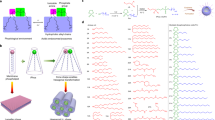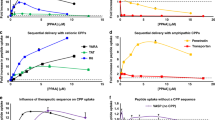Abstract
Eleven structural analogues of two known cationic lipids, N-[1-(2,3-dioleyloxy)propyl]-N,N,N-trimethylammonium chloride (DOTMA) and N-[1-(2,3-dioleoyloxy)propyl]-N,N,N-trimethylammonium chloride (DOTAP) were synthesized and utilized to evaluate the structural characteristics of DOTMA for its high intravenous transfection activity. Using a CMV-driven expression system and luciferase gene as a reporter, the transfection activity of these analogues was evaluated in mice using tail vein injection. Results concerning the structure–activity relationship with regard to the influence of the backbone, relative position between head group and the hydrophobic chains on the backbone, linkage bonds, as well as the composition of the aliphatic chains revealed that cationic lipids which give a higher in vivo transfection activity share the following structural characteristics: (1) cationic head group and its neighboring aliphatic chain being in a 1,2-relationship on the backbone; (2) ether bond for bridging the aliphatic chains to the backbone; and (3) paired oleyl chains as the hydrophobic anchor. Cationic lipids without these structural features had lower in vivo transfection activity. These structural characteristics, however, did not significantly influence their in vitro transfection activity. The contribution that cationic lipids make to the overall in vivo transfection activity is likely to be determined by the structure of DNA/lipid complexes and by the outcome of the interaction between the DNA/lipid complexes and blood components upon intravenous administration.
This is a preview of subscription content, access via your institution
Access options
Subscribe to this journal
Receive 12 print issues and online access
$259.00 per year
only $21.58 per issue
Buy this article
- Purchase on Springer Link
- Instant access to full article PDF
Prices may be subject to local taxes which are calculated during checkout





Similar content being viewed by others
References
Brigham KL et al. In vivo transfection of murine lungs with a functioning prokaryotic gene using a liposome vehicle Am J Med Sci 1989 298: 278–281
Zhu N, Liggitt D, Liu R, Debs R . Systemic gene expression after intravenous DNA delivery into adult mice Science 1993 261: 209–211
Liu F, Qi H, Huang L, Liu D . Factors controlling the efficiency of cationic lipid-mediated transfection in vivo via intravenous administration Gene Therapy 1997 4: 517–523
Song YK, Liu F, Chu SY, Liu D . Characterization of cationic liposome-mediated gene transfer in vivo by intravenous administration Hum Gene Ther 1997 8: 1585–1594
Thierry A et al. Systemic gene therapy: biodistribution and long-term expression of a transgene in mice Proc Natl Acad Sci USA 1995 92: 9742–9746
Liu Y et al. Cationic liposome-mediated intravenous gene delivery J Bio Chem 1995 270: 24864–24870
Solodin I et al. A novel series of amphiphilic imidazolinium compounds for in vitro and in vivo gene delivery Biochemistry 1995 34: 13537–13544
Liu Y et al. Factors influencing the efficiency of cationic liposome-mediated intravenous gene delivery Nat Biotech 1997 15: 167–173
Li S, Huang L . In vivo gene transfer via intravenous administration of cationic lipid-protamine–DNA (LPD) complexes Gene Therapy 1997 4: 891–900
Hong K, Zheng W, Baker A, Papahadjorpoulos D . Stabilization of cationic liposome–plasmid DNA complexes by polyamine and poly(ethyleneglycol) phospholipid conjugates for efficient in vivo gene delivery FEBS Lett 1997 400: 233–237
McLean JW et al. Organ-specific endothelial cell uptake of cationic liposome–DNA complexes in mice Am J Physiol 1997 273: H387–H404
Templeton NS et al. Improved DNA: liposome complexes for increased systemic delivery and gene expression Nat Biotech 1997 15: 647–652
Wang JK et al. Synthesis and characterization of long chain alkyl acyl carnitine esters. Potentially biodegradable cationic lipids for use in gene delivery J Med Chem 1998 41: 2207–2215
Barron L, Mayer KB, Szoka FC Jr . Effects of complement depletion on the pharmacokinetics and gene delivery mediated by cationic lipids–DNA complex Hum Gene Ther 1998 9: 315–323
Mahato RI et al. Biodistribution and gene expression of lipid/plasmid complexes after systemic administration Hum Gene Ther 1998 9: 2083–2099
Barron L, Gagne L, Szoka FC Jr . Lipoplex-mediated gene delivery to the lung occurs within 60 minutes of intravenous administration Hum Gene Ther 1999 10: 1683–1694
Gao X, Huang L . Cationic liposome-mediated gene transfer Gene Therapy 1996 3: 710–722
Felgner PL et al. Lipofection: a highly efficient, lipid-mediated DNA-transfection procedure Proc Natl Acad Sci USA 1987 84: 7413–7417
Leventis R, Silvius JR . Interactions of mammalian cells with lipid dispersion containing novel metabolizeable cationic amphiphiles Biochim Biophys Acta 1990 1023: 123–132
Ren T, Liu D . Synthesis of cationic lipids from 1,2,4-butanetriol Tetrahedron Lett 1999 40: 209–212
Ren T, Liu D . Synthesis of diether-linked cationic lipids for gene delivery Bioorg Med Chem Lett 1999 9: 1247–1250
Lee RJ, Huang L . Lipid vector system for gene transfer Crit Rev Therapeutic Drug Carrier Systems 1997 14: 173–206
Miller AD . Cationic liposomes for gene therapy Angew Chem Int Ed Engl 1998 37: 1768–1785
Byk G et al. Synthesis, activity, and structure–activity relationship studies of novel cationic lipids for DNA transfer J Med Chem 1998 41: 224–235
Behr JP et al. Efficient gene transfer into mammalian primary endocrine cells with lipopolyamine-coated DNA Proc Natl Acad Sci USA 1989 86: 6982–6986
Felgner JH et al. Enhanced gene delivery and mechanism studies with novel series of cationic lipid formulation J Biol Chem 1994 269: 2550–2561
Wheeler CJ et al. A novel cationic lipid greatly enhances plasmid DNA delivery and expression in mouse lung Proc Natl Acad Sci USA 1996 93: 11454–11459
Balasubramaniam RP et al. Structure and functional analysis of cationic transfection lipids: the hydrophobic domain Gene Therapy 1996 3: 163–172
Bennett MJ et al. Cationic lipid-mediated gene delivery to murine lung: correlation of lipid hydration with in vivo transfection activity J Med Chem 1997 40: 4069–4078
Gao X, Huang L . A novel cationic liposome reagent for efficient transfection of mammalian cells Biochem Biophys Res Commun 1991 179: 280–285
Lee ER et al. Detailed analysis of structures and formulations of cationic lipids for efficient gene transfer to lung Hum Gene Ther 1996 7: 1701–1717
Cooper RG et al. Polyamine analogues of 3β-[N-(N′,N′-dimethylaminoethane) carbamoyl]cholesterol (DC-Chol) as agents for gene delivery Chem Euro J 1998 4: 137–151
Huang L, Hung M, Wagner E (eds) . Nonviral Vectors for Gene Therapy Academic Press: San Diego 1999
Sambrook J, Fritsch EF, Maniatis T . Molecular Cloning: A Laboratory Manual Cold Spring Harbor Laboratory Press: New York 1989 pp 1.21–1.24.
Acknowledgements
Assistance from Professor Balwant Dixit for critical reading of this manuscript is acknowledged. DOTMA was kindly provided by Roche Bioscience. This work was supported in part by a grant from NIH (CA 72925) and research contract with Targeted Genetics Corporation.
Author information
Authors and Affiliations
Rights and permissions
About this article
Cite this article
Ren, T., Song, Y., Zhang, G. et al. Structural basis of DOTMA for its high intravenous transfection activity in mouse. Gene Ther 7, 764–768 (2000). https://doi.org/10.1038/sj.gt.3301153
Received:
Accepted:
Published:
Issue Date:
DOI: https://doi.org/10.1038/sj.gt.3301153
Keywords
This article is cited by
-
Structure and Function of Cationic and Ionizable Lipids for Nucleic Acid Delivery
Pharmaceutical Research (2023)
-
Therapeutic Delivery of MicroRNA-29b by Cationic Lipoplexes for Lung Cancer
Molecular Therapy - Nucleic Acids (2013)
-
An Amino Acid-based Amphoteric Liposomal Delivery System for Systemic Administration of siRNA
Molecular Therapy (2011)



